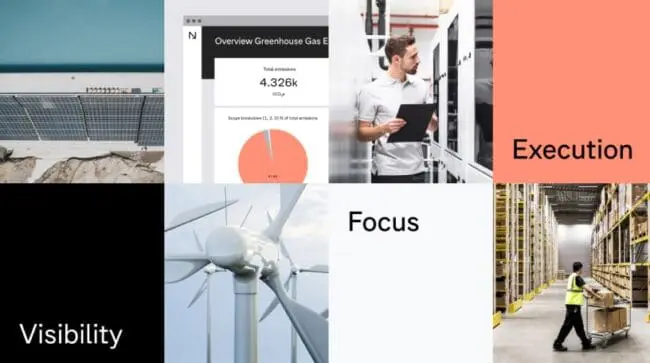Delivering net-zero emissions: a three-step approach for businesses

How to bridge the gap between commitment and action to achieve your net-zero targets.
Businesses will play a crucial role in driving the transition towards a net-zero future.
Recent research shows that while net-zero commitments are increasing, there is still an execution gap between the commitments made and the actions taken.
There is no negotiation with nature. To avoid the worst impacts of climate change, we must reach global net zero by 2050. Commitments alone won’t get us there. It’s time to deliver on our net-zero commitments.
This article explains how business leaders can bridge the gap between commitment and action to achieve net zero.
While every business’s climate journey is unique, there are three pillars at the core of an effective net-zero strategy:
- Visibility: First, you need to know where you are on the path to net zero – and what moving forward will require.
- Focus: Narrow down your options to plan strategic action.
- Execution: With the path made visible and the focus set, it’s time to deliver results.
What does “net zero” mean?
A business that has reached net zero doesn’t contribute any additional greenhouse gas to the atmosphere on balance. Any emissions are counterbalanced by carbon removal.
Learn more
Make carbon visible
There is a business adage that states: “You can’t manage what you can’t measure.” The same principle holds true for greenhouse gas emissions: if you can’t see your carbon, you can’t address it.
You can make your business’s emissions visible by using carbon accounting. Like financial accounting, carbon accounting quantifies the impact of an organization’s business activities – though instead of financial impact, it tracks climate impact.
Using carbon accounting to gain full visibility over all of your business’s emissions – including scope 3 – will require collecting data from throughout your organization and value chain. The value chain presents a particular challenge for many businesses: to quantify the emissions from your business’s upstream and downstream activities, you will have to collect data from your suppliers, a process that is complicated by the complex and global nature of modern value chains.
However, despite the challenges, engaging the value chain is essential for businesses that are setting or working toward net-zero targets. According to a CDP examination of businesses across sectors, the value chain accounts for approximately 88% of emissions. Quantifying these emissions is the necessary foundation for driving effective value chain decarbonization – and making significant progress toward your net-zero goal.
The Carbon Network empowers value chain visibility & reduction
Normative’s Carbon Network helps your business collaborate with suppliers to source data, gain scope 3 emissions insights, and drive real carbon reductions.
Learn more about the Carbon NetworkFocus your efforts
Once your business’s carbon emissions have been made visible through carbon accounting, you may feel overwhelmed by the options available to take action. How do you overcome this feeling and take strategic action that propels your business toward meeting your net-zero commitment?
First, it’s crucial not to defer action to a later point in time. You can think of deferring action in terms of accruing “carbon debt” – the longer you wait to begin action, the more the challenges will build up in the meantime, and the more drastic and/or costly your action will need to become as the target date draws nearer. As the saying goes, the best time to start was yesterday, and the second-best time to start is now.
Second, while taking action immediately is important, it’s equally vital to focus your efforts on the most impactful and quickest results. You can achieve this by using your carbon insights to target the emissions hotspots in your operations or value chain.
It is also helpful to engage internal stakeholders as early as possible in the process. As the industrial manufacturer Norican learned while working toward net zero, decarbonization is a whole-company effort. Make sure to communicate internally about the benefits of decarbonization – which go beyond sustainability and bring significant competitive advantages.
Join the Normative Net-Zero Community
Join this free community to connect with industry peers and learn how carbon accounting can empower you to decarbonize your business.
Go to the Net-Zero Community
Execute net-zero action
Once your carbon is visible and your strategic focus is set, it’s time to take action.
The specific reduction actions will vary depending on factors such as your business’s industry, maturity, and specific circumstances. However, for most businesses, working toward net zero will primarily involve decarbonizing the value chain. This can be done in many ways, including encouraging suppliers to reduce emissions and switching to lower-carbon materials.
Even for businesses with robust internal sustainability knowledge, it can be beneficial to work with experts who have specialized knowledge and experience in helping businesses reach net-zero goals – experts like Normative’s Climate Strategy team.
Additionally, learning from and sharing best practices with peers at other companies – in forums like the Net-Zero Community – can accelerate your progress.
While the paths to net zero are varied, this overview should help you kick-start your efforts to turn your climate commitments into climate action.
The net-zero strategy, in brief
- Make carbon visible to build the foundation for taking effective climate action.
- Focus your efforts to turn carbon insights into a data-driven strategy.
- Execute net-zero action by seeking expert guidance and engaging suppliers.
Normative empowers you to reach net zero
Use Normative to guide your company along the path to net zero, wherever you are on the journey.
FAQs
Frequently asked questions about net-zero strategy.
A net-zero strategy is a comprehensive plan to first reduce emissions as much as possible, then to counterbalance any residual emissions with carbon removal.
The three steps to reaching net zero are to 1) make carbon visible, 2) focus your efforts, and 3) execute net-zero action.
A company’s net-zero strategy will focus specifically on reducing greenhouse gas emissions, whereas an ESG strategy will include other environmental elements – such as water and land usage – as well as social and governance impacts. A net-zero strategy can be contained within a broader ESG strategy.











